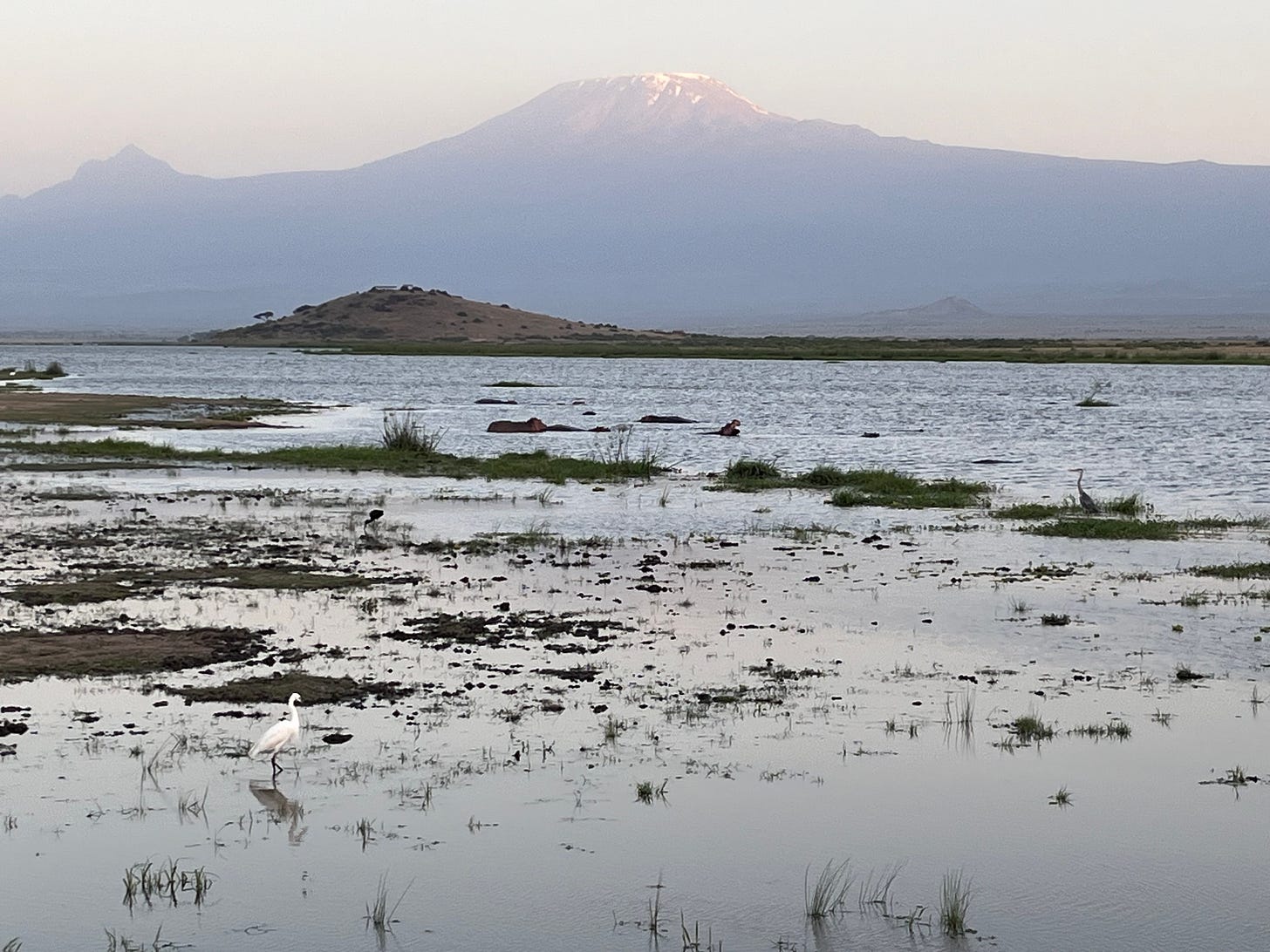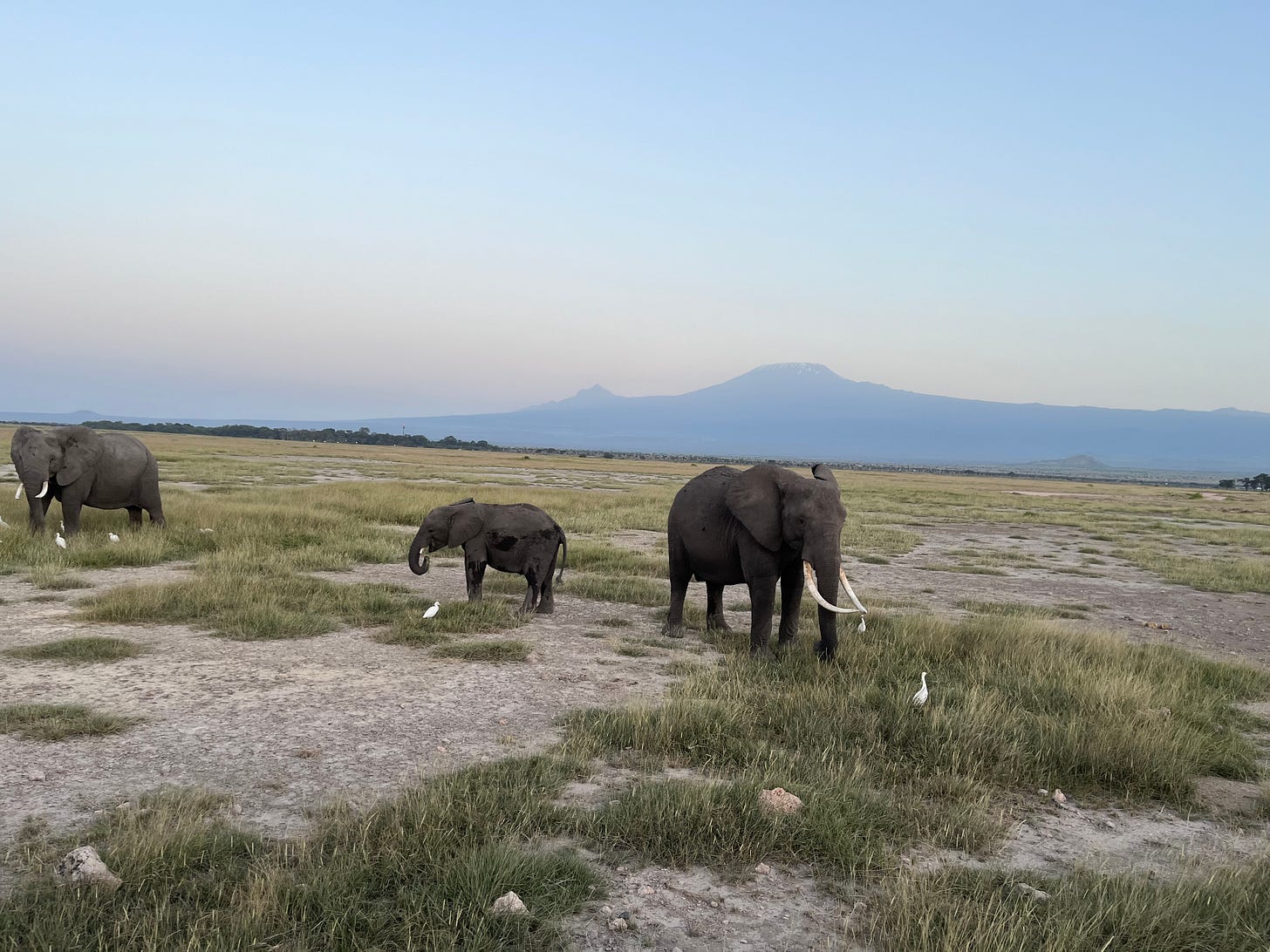Amboseli, Kenya
June 5, 2025
[NB: Our journey started last weekend. Previous installments are here, here, here, here, here, and here]
“A zebra doesn’t change its spots.”
- Al Gore
The Masai call the western crest of Kilamanjaro the Ngàje Ngài, the “House of God”. Time won’t permit us to ascend the summit. But we’re pleased to be on the Lord’s lawn.
The drive from Arusha to Namanga is desolate, like central Nevada with more shrubs and worse roads. But the Kenyan version made our Tanzanian trek feel like the autobahn.
One-Stop Shop
We breached the border with little difficulty. Named for the neighboring hills, the Namanga crossing is a “one-stop” shop that processes travelers transiting between Tanzania and Kenya.
A single room with the national boundary between two plexiglass windows, it operates more by whim than regulation. Passage is mostly a matter of each agent’s mood.
Sometimes fingerprints are taken. Occasionally, health records are checked. Every once in a while, luggage is screened. From time to time, some travelers are simply waved thru. East African whimsy isn’t confined to borders.
Earlier this week, flying from Serengeti to Arusha, the metal detectors and luggage screeners were on the fritz. In the U.S., flights would’ve been delayed or canceled till security theater could be resumed.
But in Seronera, shoulders shrugged. Thru the small airport we walked without question or inspection onto the tarmac, and proceeded to the plane with all the formality of boarding a bus.
To avoid screening at Namanga, our bags were carried around inspection by locals having good “relationships” with border officials.
Bribes are common in Kenya, as they are in almost every country. This includes the United States, where they’re commonly called “speaking fees”, “book advances”, or “campaign contributions.”
All we offered were brief answers to whatever was asked, which wasn’t much. Tanzanian agents and Kenyan officials were smiling and pleasant. Each side checked our visas, stamped our passport… and moved us along.
The real gauntlet came next.
Mobs of Masai women “greeted” us as walked toward our truck. We averted our eyes from the barrage of beads they brandished to lighten our wallets.
Tho’ it’s tempting to make token purchases to alleviate their plight, signs of interest or empathy would cause the swarm to surge. Heads down and legs churning, we parted the pack and found our truck.
Secure in our seats, we turned from the window. Outside, the pleading persisted. Faces and hands pressed the panes till we drove away.
Corrugated Road
The “road” from Namanga to Amboseli removed a few fillings. It was like riding in a paint shaker. There’s apparently a plan to pave the path, in anticipation of which speculators are buying plots of adjacent real estate.
It’s now occupied by dilapidated shacks, a few missionary schools, periodic corn, plenty of coffee, and occasional cattle.
Moving north from the border, trees multiplied and foliage thickened. Mountains resembled the Appalachians, covered from piedmont to peak in a sheath of green. But during the incipient dry season, most vegetation will wither away.
Continuing into the country, cows, giraffes, and jackals nibbled leaves and grass along the corrugated “road.”
Agriculture is the largest industry in Kenya, fueled mostly by exports of coffee, tea, and flowers. Starbucks is among the bigger buyers of beans, while the Netherlands imports the most Kenyan flowers.
The dominant tribe in Kenya is the Kikuyu, found mostly in the central part of the country. Originally farmers, they are becoming more proficient in business.
Swahili is the most common language, tho English is the official one. Eighty percent of Kenyans are Christian. As in Tanzania, the legacy of Arab traders concentrated Islam on the coast. Traditional beliefs of forty-four tribes honeycomb the country.
As terrain flattened and foliage thinned, trees yielded to dry scrub. An import from South America, prickly pear made an appearance. Dust rose when the wind whipped, an appropriate entré to Amboseli.
The Only Kink
Kilamanjaro loomed above us as we passed the gate. This protrusion from the plain has three peaks formed by volcanic eruptions over millions of years. One is now dormant, while two have merged over time.
The highest free-standing summit in the world moved from Kenya to Tanzania when Queen Victoria gifted the mountain to her nephew… who would eventually become the German Kaiser.
Or so the story goes.
It’s superficially plausible, but probably apocryphal. The boundary was among many artificial constructs drawn in European boardrooms during the “scramble for Africa”. This one was etched in 1886.
From Lake Victoria to the Indian Ocean, it separates Kenya from Tanzania in one of those unnaturally straight lines that denote political chicanery around the globe. The only kink is where Kilamanjaro sits.
This came from negotiations that allowed German East Africa to keep the peak. They did so till the First World War.
Britain’s vast empire was her Achilles heel. To relieve pressure on its forces in Europe, the Germans decided to expand the war around the world… including British holdings in East Africa.
In this theater, imperial powers relied on others to do their fighting. The Germans conscripted thousands of natives. The British imported Indians, or impressed those who were already here. Most were poorly trained, and understandably indifferent to this internecine squabble.
When the fighting was finished, Britain received Tanganyika, which retained the mountain. But Kenya kept the view.
Measured in Teeth
It’s most visible from Amboseli, a European distortion of a Masai word meaning “salty dust.” It’s an apt appellation. Wherever we go, a white coat covers the earth or sprays the air.
In Amboseli, elephants are everywhere, like “painted ladies” near a naval base. This attribute makes it a prime destination for wildlife enthusiasts.
Up to 2,000 elephants roam the Amboseli ecosystem, which features that animal the way Serengeti offered up Lions. Many familiar faces are also here: wildebeest, zebra, warthogs, and hippos.
But elephants are most prominent. Their lifespan is measured in teeth, of which they exhaust six sets over as many decades. When they lose the last one, they’re unable to eat. Before long, the great beasts starve to death.
Unless people get them first.
Human hunters are the main threat to African elephants. Amboseli rhinoceri have already been poached to extinction, so harsh measures try to protect these pachyderms. Poachers can be legally shot on sight.
Recent rains washed away what pass for “roads”, making passage thru the park particularly bumpy. But the most reliable water comes from below.
Kilamanjaro snow is there all year, replenishing Amboseli ponds thru underground fissures formed when the mountain erupted millions of years ago.
Palms are more prevalent here than in other places we’ve been, yet dry grassland remains pervasive. But reliable water attracts the elephants, while brackish pools become home to hippos. Antelope, wildebeest, and zebra all appreciate the ample supply.
But only if they can get to it. Late yesterday under an impending dusk, a lone zebra lay prone on the ground.
His solitude and position were each unusual. Zebras are ornery, but rarely alone. They’re often around other animals as well as each other.
But this zebra was by himself. He was obviously debilitated, most likely from the venom of a viper.
Whether from poison or predators, he likely knew his days were done. When the sun set, he’d likely have his last night on the Lord’s lawn.
JD







👍👍👍 ❤❤❤ 🔥🔥🔥
Arching through geology, biology, politics, economics, religion, ethnography while bumping in a paint-shaker ...
What a feat ...